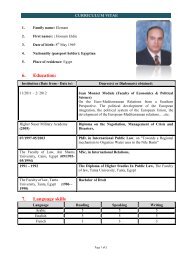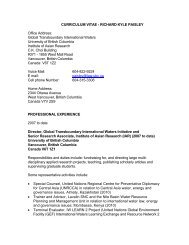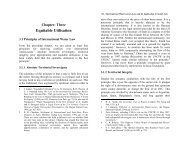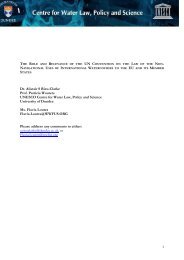Upreti, Trilochan, International Watercourses Law and Its Application ...
Upreti, Trilochan, International Watercourses Law and Its Application ...
Upreti, Trilochan, International Watercourses Law and Its Application ...
Create successful ePaper yourself
Turn your PDF publications into a flip-book with our unique Google optimized e-Paper software.
94 / <strong>International</strong> <strong>Watercourses</strong> <strong>Law</strong> <strong>and</strong> <strong>Its</strong> <strong>Application</strong> in South Asia Development <strong>and</strong> Codification of <strong>International</strong> <strong>Watercourses</strong> <strong>Law</strong> / 95to the present convention, or any time thereafter, states maydeclare that they recognise as compulsory, submission ofdisputes to the ICJ or an arbitration tribunal.Being the first instrument of universal application with anintegrated <strong>and</strong> holistic <strong>and</strong> framework approach, the UNCIWhas definitely codified many aspects of Customary <strong>International</strong><strong>Law</strong>, viz. equitable utilisation with the full consideration ofsustainable utilisation of such resources. 208 The other fact isthat the provisions of this convention will not affect the existingtreaty regimes among <strong>and</strong> between nations. However, if thestate parties are willing to bring these treaties in line with thisconvention, they can adjust it as <strong>and</strong> when they deem itappropriate. The regional agreements will also remainunaffected regardless of the fact that a regional economic blochas the right to become a party of this convention. 209 It must berecognised that the convention does not affect existing treatyregimes <strong>and</strong> these principles are only applicable when stateswish to follow them.From the view of the discussion in the ILC <strong>and</strong> in the sixthcommittee, <strong>and</strong> the voting pattern in the UNGA relating to theUNCIW, there is a delicate balance <strong>and</strong> a package deal ofArticles 5, 6 <strong>and</strong> 7, on which 38 states voted for, 4 states(China, France, Tanzania <strong>and</strong> Turkey) against, <strong>and</strong> 22abstained. From the ILC to the Sixth Committee discussions,states were hugely divided, protecting their individual interestsdownstream versus upstream. Different views were held as towhich rules - ‘equitable utilisation’ or the ‘no harm rule’ shouldsupersede the other. 210 The voting pattern on the substantiveissues suggests that the members voting against or abstainingwere equivalent to the number of states voting in favour. Inorder to implement these principles, states must have separatebilateral or multilateral agreements. From the voting pattern it208 Supra note 2, pp. 308.209 II (2) YBILC (1994), commentary, pp. 95-97.210 Press release/ UNGA/9248, 22 May 1997.appeared that both upstream <strong>and</strong> downstream states findstrengths <strong>and</strong> weakness in the final formulation of the articles,as a result of which it can be argued that these provisions lackthe status of customary rule of international law. Furthermore,the compulsory dispute settlement provision under Article 33(10) remains a major area of criticism by a number of powerfulnations. 2112.9.4 The Institute of <strong>International</strong> <strong>Law</strong>This institute has played a pivotal role in the development <strong>and</strong>codification efforts of international law since the nineteenthcentury, including the codification of UNCIW. The<strong>International</strong> Regulation on the Use of IWC for Purposes Otherthan Navigation (Declaration of Madrid), 1911, prohibits anystate from using or allowing the use of the waters of aninternational stream in a way that may cause detrimentalimpacts to other states. 212 Article II prohibits any establishmentin a stream that traverses successively the territories of two ormore states, without the consent of the other states. Along thesame lines, Article II (5) prohibits any construction in thedownstream country that could be the subject of inundation inother state territories. Those rules, however, are not legallybinding even though they are considered as general guidelinesfor states. As demonstrated earlier, the Helsinki Rules, 1966,the UNCNIW 1997, <strong>and</strong> several concepts <strong>and</strong> developmentsaddressed by these Rules are contributions of the Institute. Forexample, the illegality of trans-boundary pollution <strong>and</strong> injury orharm arising from the use of the waters in a state that affectother states is a concept inherited from the earliest works of theILI.Another pertinent instrument is the Resolution of the Use of<strong>International</strong> Non-Maritime Waters Salzburg 1961. This rule211 Ibid.212 Supra note 57 pp. 274-275.












